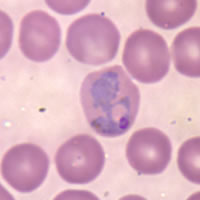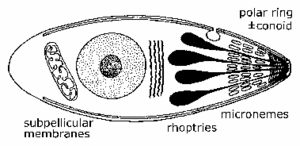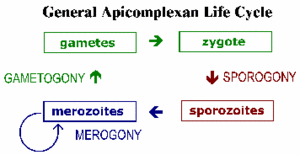Apicomplex: Difference between revisions
No edit summary |
No edit summary |
||
| Line 1: | Line 1: | ||
{{Curated}} | |||
{{Biorealm Phylum}} | {{Biorealm Phylum}} | ||
Latest revision as of 14:56, 7 August 2010
A Microbial Biorealm page on the phylum Apicomplex

Classification
Higher order taxa:
Eukaryota; Alveolata
Genera:
Babesia; Leucocytozoon; Plasmodium, Sarcocystis
Description and Significance
Apicomplexa is a phylum made up almost entirely of parasites. Apicomplexans are distinguished by their unique method of entering host cells. Apicomplexan parasites cause a number of serious illnesses, such as babesiosis in dogs and cattle, leucocytozoonosis in birds, and most significantly malaria in humans. They are grouped with dinoflagellates and ciliates to make up the Alveolata, a higher order whose most common shared characteristic is the cortical alveolae, flattened vesicle-like structures which are found just under the plasma membrane. Unlike their Alveolate relations, however, Apicomplexans have undergone degenerative evolution, losing all flagella and cilia. Their unique characteristic, the product of past endosymbiosis, is the apical complex, a group of secretory organelles, in particular the apicoplast, which enable the parasitic cells to invade the host cell.
Genome Structure
The biggest breakthrough in mapping Apicomplexan genome structures came in 2002, with the completion of the human malaria-causing Plasmodium falciparum genome sequence. For complete data on this vital medical achievement, click here.
Cell Structure and Metabolism
Cell structure of Apicomplexa.


As noted above, Apicomplexans are unique in their method of invading host cells, specifically by the presence of the apical complex and apicoplast. This cluster of secretory organelles found at one end of the cell is made up of micronemes, rhoptries, polar rings made up of microtubules, and in some species a conoid, which lies within the polar rings. These organelles are utilized during parasite-host ineraction, providing the cells with the ability to secrete enzymes and other proteins which erode extracellular material and allow the parasite to enter the host cell.
The typical Apicomplexan life cycle is comprised of three stages: sporogony, merogony, and gametogony.
Sporogony occurs when the parasite is injected into the host by the vector. Asexual reproduction occurs, resulting in sporozoites. Another asexual replication follows this, called merogony, where the sporozoites become merozoites. Merogony may occur a number of times and in various locations in the host; these variations vary depending on the species. Sometimes sexual instead of asexual reproduction may occur; this is referred to as gametogony, gamogony, or gametogenesis. Regardless of the title, gametes are formed, which then combine to form zygotes. The zygotes morph into a form which yields sporozoites, starting the cycle over.
Ecology
Apicomplexan hosts range from humans to rodents to dogs to horses. Distribution varies according to species; some are concentrated in tropical or subtropical areas where the specific requirements of the parasite are meant, while others may be found in parts of North America, Europe, and Asia. Most life cycles involve two hosts: the intermediate invertebrate (insect) vector and the definitive vertebrate host, although some species may also be spread from vertebrate host to vertebrate host. Currently many Apicomplexans, most famously the genus Plasmodium, are under close observation and are being researched extensively.
References
Apicomplexa. Center for Veterinary Health Sciences, Oklahoma State University. Copyright 2004.
Sporozoa-Apicomplexa. Department of Zoology, University of British Columbia.
Wiser, Mark F. Apicomplexa. Tulane University School of Public Health. Last updated January 6 2004.
